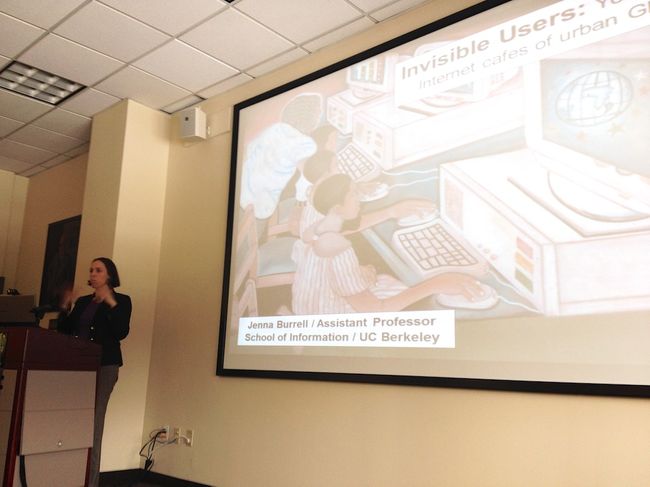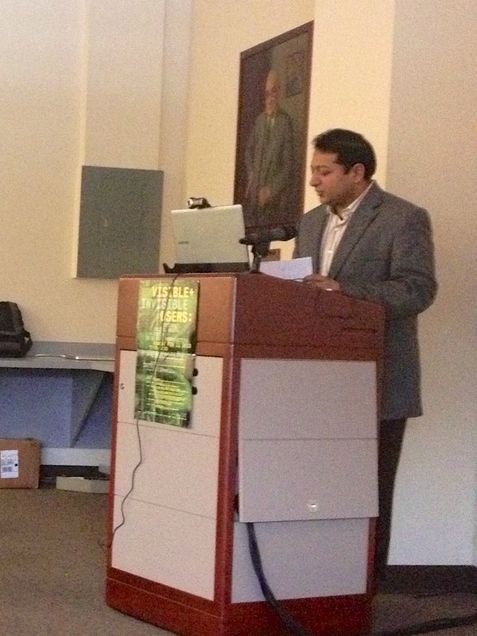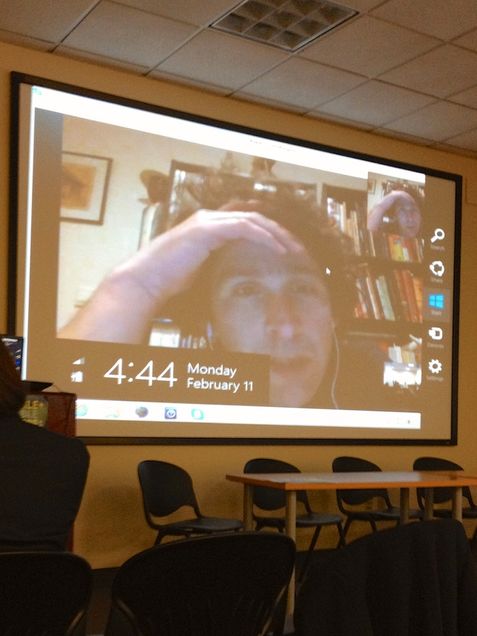EVENT REVIEW: Visible + Invisible Users: Internet, Social Media, and Youth in Global Perspective
On February 11, 2013, the Boston University Center for the Study of Asia (BUCSA), in co-sponsorship and collaboration with the African Studies Center, Program in Latin American Studies, the College of Communication, and the Boston University Center for Humanities, hosted Visible + Invisible Users: Internet, Social Media, and Youth in Global Perspective, an interdisciplinary symposium on the impact, influence, and interactions of youth and internet use in a global context. Stepping away from quantitative measurements and an overt focus on youth politicization of the internt, the afternoon explored the on-the-ground “soft” uses: entertainment, celebrities, sociability, and crowdsourced aggregations of data.
The afternoon began with a warm welcome from Eugenio Menegon, the Director of BUCSA. Following, our facilitator for the symposium, Mina Tsay-Vogel, Assistant Professor at Boston University’s College of Communication, discussed the format and schedule of the afternoon and introduced our speakers.
 Beginning the talks of the day was Jenna Burrell, Assistant Professor at the University of California at Berkeley’s School of Information. She had recently published Invisible Users: Youth in the Internet Cafés of Urban Ghana from which the symposium took as its leaping off point. She discussed the contrast and tension between the activities occurring through the use of the computers in sharp contrast to the environment of the internet cafés. Although each user, through the use of divisions and the cold clinical tiles and minimalistic decor of the physical space, were rendered solitary and alone, the main activity undertaken was one that had tones of escapism. Users were using computers as a means to “travel through” to find patrons, friends, romantic partners, income and education opportunities. Jenna’s findings complicated the notions that internet use were localized in the classic global/local processes. Instead, these cafés could almost be related as tools through which to get Anywhere But Here. To reach out and meet the global.
Beginning the talks of the day was Jenna Burrell, Assistant Professor at the University of California at Berkeley’s School of Information. She had recently published Invisible Users: Youth in the Internet Cafés of Urban Ghana from which the symposium took as its leaping off point. She discussed the contrast and tension between the activities occurring through the use of the computers in sharp contrast to the environment of the internet cafés. Although each user, through the use of divisions and the cold clinical tiles and minimalistic decor of the physical space, were rendered solitary and alone, the main activity undertaken was one that had tones of escapism. Users were using computers as a means to “travel through” to find patrons, friends, romantic partners, income and education opportunities. Jenna’s findings complicated the notions that internet use were localized in the classic global/local processes. Instead, these cafés could almost be related as tools through which to get Anywhere But Here. To reach out and meet the global.
 Next to speak was Paola Prado, an Assistant Professor at Roger Williams University’s Dept. of Communication. Her talk, entitled “Digital Inclusion among Marginalized Youth in Brazil” addressed a very different phenomenon to Jenna’s. Even as Brazilian youth and internet use were beginning to veer more and more into the non-local services, local youth were still translating these services into unique products that served them, including the crowdsourced data resource for traffic, potholes, accidents, and other motorist conditions. Her research also complicated the normative narrative on how the developing world is using technology. In her findings, it is not the elite and the ‘digirati’ that are at the forefront of computer purchase and use. Instead, it is the families in the favelas (informal squatter settlements) that are doing most of the purchasing. At one point, she joked, ‘Doesn’t your ghetto get full wifi coverage?’ And as Jenna noted, for the most part, internet use has an escapist quality, where users were more likely to use it for entertainment than any other purpose.
Next to speak was Paola Prado, an Assistant Professor at Roger Williams University’s Dept. of Communication. Her talk, entitled “Digital Inclusion among Marginalized Youth in Brazil” addressed a very different phenomenon to Jenna’s. Even as Brazilian youth and internet use were beginning to veer more and more into the non-local services, local youth were still translating these services into unique products that served them, including the crowdsourced data resource for traffic, potholes, accidents, and other motorist conditions. Her research also complicated the normative narrative on how the developing world is using technology. In her findings, it is not the elite and the ‘digirati’ that are at the forefront of computer purchase and use. Instead, it is the families in the favelas (informal squatter settlements) that are doing most of the purchasing. At one point, she joked, ‘Doesn’t your ghetto get full wifi coverage?’ And as Jenna noted, for the most part, internet use has an escapist quality, where users were more likely to use it for entertainment than any other purpose.
 In fact, the third speaker of the afternoon, Anshul Jain, a Ph.D. Candidate at Boston University’s Department of Political Science, shared that his preliminary dissertation findings revealed that the most significant driver for social media participation was not politicization or other arguments for instrumentation. In fact, it was based on whether or not they had a friend who was overseas. And the most discussed topics online were not politics or other “soft” news topics or issues. Instead, the conversations steered toward the social and the cultural: movies, celebrities, etc. Perhaps, Jain suggested, ‘People aren’t as unhappy as we might suspect.’ Issues of identity and identity formation/reformation through the processes of migration were discussed as well. It seemed that the main changes that occurs is that a broader categorization shifts into the center as the primary identification. A sort of homogenization occurs in conversations between overseas Indians versus Indians still residing in India. Meaning: geographic particularities, caste, and other social markers of difference, while relevant across all communications, seem to bear more weight amongst Indians-in-India populations in contrast to overseas Indians, who supercede these more nuanced identity markers by cohering around a wider identity of being Indian.
In fact, the third speaker of the afternoon, Anshul Jain, a Ph.D. Candidate at Boston University’s Department of Political Science, shared that his preliminary dissertation findings revealed that the most significant driver for social media participation was not politicization or other arguments for instrumentation. In fact, it was based on whether or not they had a friend who was overseas. And the most discussed topics online were not politics or other “soft” news topics or issues. Instead, the conversations steered toward the social and the cultural: movies, celebrities, etc. Perhaps, Jain suggested, ‘People aren’t as unhappy as we might suspect.’ Issues of identity and identity formation/reformation through the processes of migration were discussed as well. It seemed that the main changes that occurs is that a broader categorization shifts into the center as the primary identification. A sort of homogenization occurs in conversations between overseas Indians versus Indians still residing in India. Meaning: geographic particularities, caste, and other social markers of difference, while relevant across all communications, seem to bear more weight amongst Indians-in-India populations in contrast to overseas Indians, who supercede these more nuanced identity markers by cohering around a wider identity of being Indian.
 Finally, as befits a symposium on global use of internet, Jeremy Goldkorn, Founder of Danwei.com, skyped in to join the conversation. (His travel plans were interrupted by the unfortunate arrival of Blizzard Nemo). Alongside similar observations thematically with the three previous speakers: the emphasis on entertainment and the pervasiveness of celebrity, the preoccupation with local concerns such as food safety and air pollution; Goldkorn also reintroduced the notions of localized innovation and adaptation (or appropriation) in the China case. Given the Great Firewall of China that prohibits Facebook and Twitter use in the country, the Chinese have innovated local alternatives that serve the same purpose. In addition, because of the political climate and censorship, most users are not likely to use their real names. Instead, much like an intensified version of Sherry Turkle‘s notion of the second self in which potential freedoms are granted through anonymity, it is in this case that perhaps we see the most overt politicization amongst users.
Finally, as befits a symposium on global use of internet, Jeremy Goldkorn, Founder of Danwei.com, skyped in to join the conversation. (His travel plans were interrupted by the unfortunate arrival of Blizzard Nemo). Alongside similar observations thematically with the three previous speakers: the emphasis on entertainment and the pervasiveness of celebrity, the preoccupation with local concerns such as food safety and air pollution; Goldkorn also reintroduced the notions of localized innovation and adaptation (or appropriation) in the China case. Given the Great Firewall of China that prohibits Facebook and Twitter use in the country, the Chinese have innovated local alternatives that serve the same purpose. In addition, because of the political climate and censorship, most users are not likely to use their real names. Instead, much like an intensified version of Sherry Turkle‘s notion of the second self in which potential freedoms are granted through anonymity, it is in this case that perhaps we see the most overt politicization amongst users.
ROUNDTABLE

All of these criss-crosses, tensions, and intricate textile that is created through the use of internet amongst youth were then discussed in a lively roundtable helmed by James E. Katz, Feld Professor of Emerging Media and the Director of Division of Emerging Media Studies at Boston University’s College of Communication. Through the roundtable, what the participants seem to arrive at is that while mobilization and politicization is certainly possible, as suggested by all of the case studies presented that afternoon, what seems to be the most salient is that ultimately, it’s the sociability and “soft” topics that seem to animate youth users. Perhaps it is as the panel participants suggest, and that the academic world has to relieve itself of its fetish that youth (in developing nations) + internet = political mobilization.